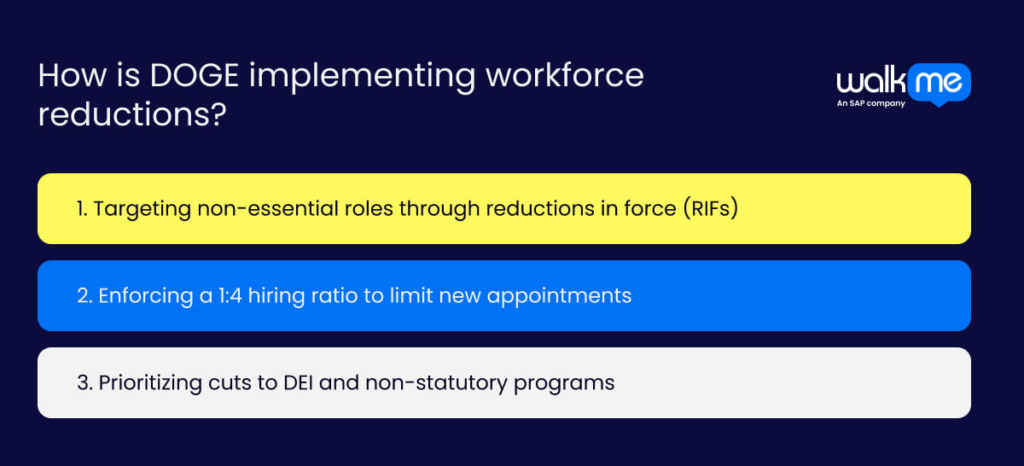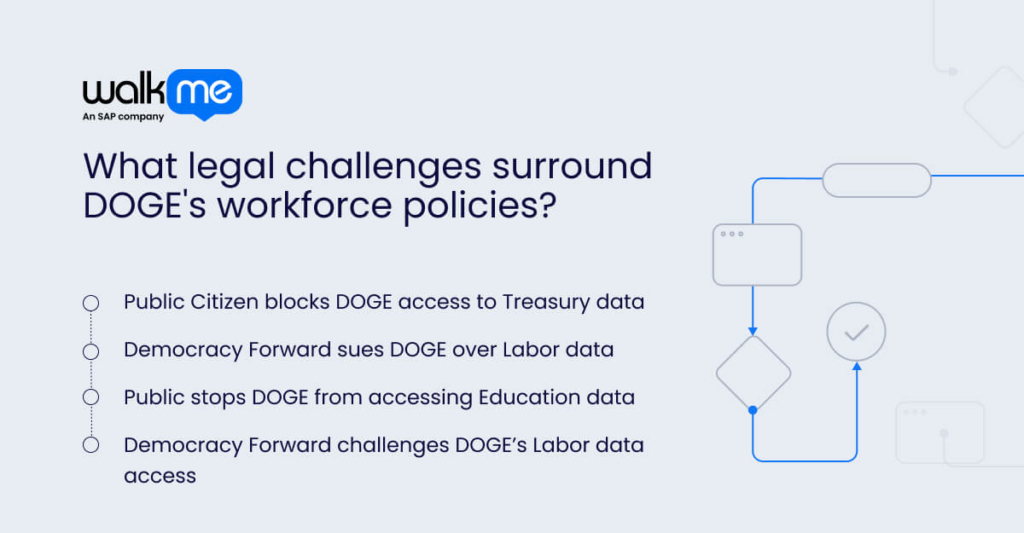For decades, the size and sprawl of the federal workforce have been treated as institutional anchors—adjusted more than reimagined.
Treating government optimization as a design challenge, rather than a cost-cutting exercise, reframes the entire conversation. In the hands of the newly minted Department of Government Efficiency (DOGE), workforce restructuring is now confronting a quietly unsustainable system and asking even harder questions.
What roles are vital in a digital-first government, and which structures best serve the public? The DOGE workforce efficiency measures are a step toward aligning government structures with evolving public needs.
With that in mind, this article examines the goals, methods, and real-world impacts of DOGE’s workforce initiative—from how roles are evaluated to where reductions are occurring and what it means for communities and agencies nationwide.
What is DOGE’s workforce optimization initiative?
The Department of Government Efficiency (DOGE) is leading a focused effort to reshape the federal workforce through strategic reductions and role realignment.
Rather than relying on broad cuts or hiring freezes, DOGE uses workforce data to identify outdated roles, overlapping functions, and gaps in mission-critical areas. The goal is to create an agile transformation within government that reflects modern operational needs, especially in areas such as digital citizen services, cybersecurity, and public response.
Retirement trends are a key part of the government’s strategy. As long-serving employees exit, DOGE is working with agencies to reassess whether those positions need to be refilled, redefined, or retired entirely.
The initiative also emphasizes reskilling and upskilling for remaining roles, ensuring that federal teams are equipped to meet modern demands.
Overall, the workforce optimization effort is helping the government focus on what’s needed and phase out what no longer serves.
Why is DOGE’s workforce optimization important?
DOGE’s workforce optimization initiative is a data-driven effort to streamline the federal workforce.
It targets inefficiencies by identifying redundant roles, slow processes, and obsolete structures. Instead of blanket cuts, it eliminates functions that no longer support agency missions.
The initiative backs agencies in reshaping teams to match current needs, especially in digitization, service delivery, and crisis response. DOGE provides frameworks to help departments decide which roles to keep, adjust, or remove.
Over time, workforce optimization will mean fewer rigid hierarchies and more adaptable teams. Roles will evolve with policy, not lag behind it.
The long-term goal is a federal workforce built to respond, adjust, and lead in an environment in constant flux.
How is DOGE implementing workforce reductions?

Now that you know what DOGE workforce optimization is and why it’s important, it’s time to look at how they implement workforce reductions.
Doing so means examining the digital tools, criteria, and strategies guiding each decision, from role assessments to agency-specific restructuring plans.
Let’s take a closer look:
Targeting non-essential roles through reductions in force (RIFs)
DOGE is using RIFs as a calculated method to retire positions that no longer align with agency missions. Instead of applying uniform cuts, each department is required to map its workforce against current operational priorities.
Roles that lack statutory backing, serve outdated functions, or duplicate existing efforts are the first to go. This approach shifts the workforce from size-based metrics to relevance-based logic. Refining what counts as “essential,” DOGE is forcing a sharper focus on value and not volume. The result is a leaner structure that doesn’t compromise public service delivery.
Enforcing a 1:4 hiring ratio to limit new appointments
DOGE is curbing workforce growth through a strict 1:4 hiring ratio. This means one new hire for every four separations. This constraint creates natural pressure on agencies to rethink how they staff critical functions. It’s about encouraging smarter deployment of existing talent.
Agencies are being pushed to automate low-value tasks, cross-train employees, and prioritize roles that directly advance mission goals. The ratio also creates a buffer for incremental change, reducing disruption while encouraging long-term discipline. This hiring rule rebalances workforce expectations with an emphasis on quality over quantity.
Prioritizing cuts to DEI and non-statutory programs
DOGE is directing agencies to scale back or eliminate programs without a statutory mandate, including many DEI offices and initiatives. These cuts reflect a broader push to narrow government focus to core legislative functions.
It’s a shift from broad programming to precision policy, and agencies are being asked to justify the legal basis and operational value of each program. If it doesn’t serve a defined, authorized purpose, it risks deactivation. The move is controversial, but DOGE frames it as a return to fundamentals, a government concentrated on what the law requires.
Which agencies are most affected by DOGE’s workforce changes?
Understanding how DOFE is implementing workforce reductions is crucial, but knowing the extent to which specific agencies are impacted reveals where the government’s operational priorities are shifting and where legacy structures are being dismantled.
Let’s take a closer look at the government departments most affected by DOGE’s workforce changes:
- Department of Energy: Fewer people are needed in older fossil fuel programs, especially in administration and outreach. More jobs are shifting to small teams focused on clean energy, nuclear safety, and power grid upgrades.
- U.S. Agency for International Development (USAID): Jobs are being reduced in non-emergency programs, especially among regional managers and policy staff. The agency now focuses more on foreign policy goals and global health work.
- Consumer Financial Protection Bureau: Outreach and education roles are being cut. DOGE keeps jobs focusing on ensuring financial rules are followed and consumers are protected.
- Department of Veterans Affairs: Some support jobs are being removed where there is an overlap across offices. DOGE is combining teams like HR and IT to allocate more money toward direct care for veterans.
- Department of Agriculture: Fewer people work in the rural and food program outreach. Key jobs now center on food safety, inspections, and new farming technologies.
- Environmental Protection Agency: The EPA’s education and outreach roles are being reduced. DOGE ensures that the agency focuses on enforcing laws and managing pollution permits.
- Department of Health and Human Services: Cuts are happening in PR and diversity offices. Jobs are shifting to teams focused on public health, Medicaid, and keeping high-risk systems safe.
- Department of the Interior: Fewer staff work in park outreach and local programs. The department is concentrating more on land care, rule enforcement, and resource allocation.
- Office of Personnel Management: To better manage government workers, overlapping roles in HR and training are being merged, and tech stacks are being integrated.
- General Services Administration: Jobs in purchasing and sustainability are being reduced. DOGE is moving toward digital tools to handle government property, contracts, and supplies.
- Small Business Administration: Some roles in regional offices and innovation teams are being cut. Main services, such as small business loans and emergency help, remain in place.
What legal challenges surround DOGE’s workforce policies?

As with any new federal initiative, DOGE’s workforce policies have sparked significant legal challenges.
Let’s examine these challenges more closely to understand how they test the limits of executive authority:
Public Citizen blocks DOGE access to Treasury data
Public Citizen took legal action to stop the Department of the Treasury from providing payroll and job records to DOGE. Their concern was that DOGE didn’t clearly explain how the data would be used or protected.
The group feels DOGE could misuse the information to make unfair job cuts, possibly violating workers’ rights. The lawsuit argues that DOGE’s actions go against privacy laws and lack proper approval. This case highlights whether DOGE can pull private federal employment data without rules or limits.
Democracy Forward sues DOGE over Labor data
Democracy Forward filed a lawsuit against DOGE for trying to access staff records from the Department of Labor. The nonprofit says DOGE didn’t follow the right legal steps and didn’t consult with unions before requesting sensitive employee information.
They worry that DOGE might use the data to cut jobs unfairly, especially in roles protected by labor laws. The case also questions whether DOGE has the right to collect such personal data in the first place and warns of reducing staff without real checks or input from those affected.
Public stops DOGE from accessing Education data
A court blocked DOGE from getting employment data from the Department of Education after a lawsuit by Public Citizen. The group argued that DOGE hadn’t explained how it would keep the data safe or follow privacy rules that protect students and staff.
Public Citizen believes DOGE’s goal is to cut jobs supporting public education. The case raises bigger questions about how government data is shared and whether new agencies like DOGE follow the law when collecting it.
Democracy Forward challenges DOGE’s Labor data access
They say the data could be used unfairly to cut jobs, especially without outside review or input from the union. The case puts pressure on DOGE to explain how it uses data and whether it follows the rules that protect public workers.
What is DOGE’s influence on federal workforce structure?
DOGE is undoubtedly reshaping the federal workforce at an unprecedented scale, which has triggered a transformation in the structures of government agencies.
Let’s take a look at how DOGE has influenced the federal workforce structure:
Impact on small metro areas with federal offices
Smaller metro areas with federal outposts are feeling the pinch. These towns often rely on agencies like the USDA or VA as top local employers. When even a handful of roles are cut, it ripples through the local economy, affecting housing, small business traffic, and public services.
DOGE’s shift toward centralization and digital workflows means fewer jobs based on region, especially in administration and support. This results in fewer stable, salaried positions in places that need them most. While cities can absorb change, smaller metros must rethink how they attract and retain economic anchors in a shrinking federal footprint.
Disproportionate effects on smaller labor markets
In smaller labor markets, federal jobs often represent reliable wages, long-term stability, and upward mobility. DOGE’s workforce reductions are unsettling that balance. Cuts to outreach, compliance, and administrative roles affect government operations and remove middle-income jobs that support local economies.
Unlike urban centers, these areas can’t quickly replace lost federal employment with private sector alternatives. The federal government is one of the few major employers in these regions, and when it scales back, the impact reshapes the economic foundation of whole communities.
Minimal impact on large metro areas
Large metro areas are mostly shielded from DOGE’s workforce changes. With diverse economies and deep federal footprints, agencies in places like Washington, D.C., Atlanta, and Chicago can absorb role reductions without major disruption. Job losses are often offset by contract work, tech-based roles, or internal reassignments.
In these cities, a cut in one department often means a shift to another. The federal presence remains strong, but more streamlined. For big metros, DOGE’s optimization offers operational recalibration that keeps core functions intact while trimming legacy overhead with little disruption.
What is the future outlook for DOGE’s workforce initiatives?
DOGE’s workforce optimization signals a lasting shift in how the federal government defines purpose, structure, and scale.
Rather than restoring old systems, the department is designing a leaner, digitally mature model that prioritizes core services while shedding legacy roles and programs.
Legal battles, public resistance, and regional fallout will continue to test the boundaries of DOGE’s authority.
Yet the direction is clear. In the coming years, we expect smaller, faster, and more responsive institutions. Deeper integration of AI and IT process automation, as well as expanded oversight of federally funded partners, will also rise to the top of federal workforce strategies.
FAQs
Many federal workers now feel less secure in their jobs. DOGE is cutting roles that aren’t seen as essential and slowing down new hiring. Some jobs are being removed or merged, especially in offices with extra layers of staff, which makes people unsure if their job will last.
Over time, there will likely be fewer federal workers overall. DOGE wants smaller teams that use technology and automation, rather than adding more people. The plan is to keep only the jobs that are needed and shift more workers into areas like tech, data, and rule enforcement.
Unions are pushing back, saying the cuts are too fast and don’t follow fair rules. Some are taking legal action, while others are asking for more say in how changes are made. Unions want to protect their members’ jobs and ensure public services don’t suffer.

